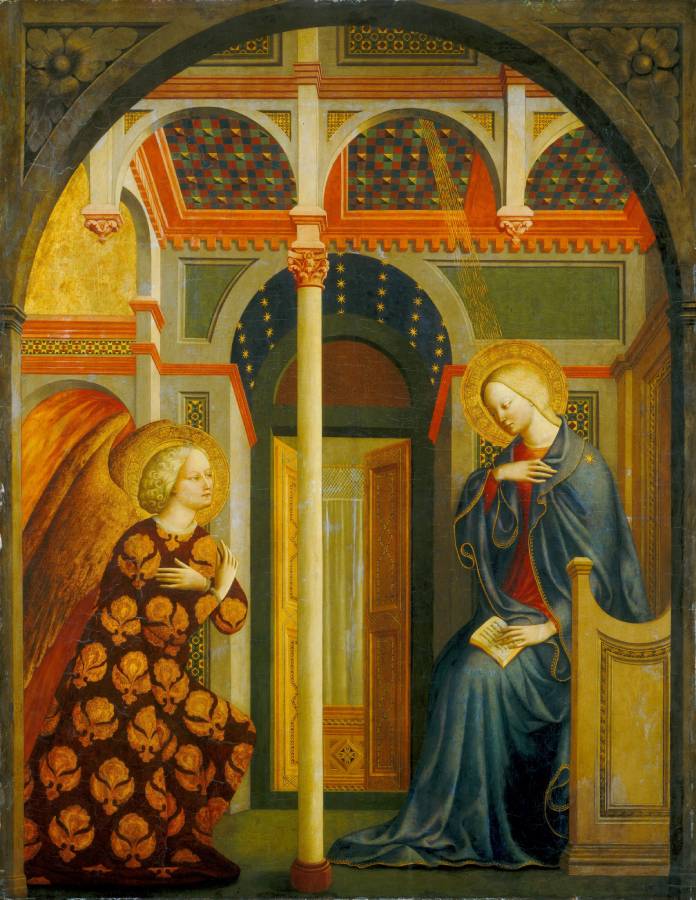Masolino da Panicale (c.1383-c.1440)
Annunciazione (The Annunciation)
c.1423–1424
Tempera on panel, 148.8 x 115.1 cm
National Gallery of Art, Washington
Inscription: on the Virgin’s prayerbook: virgo / [c]oncipiet / [e]t p[a]ri[et] / fili[um et vocabitur nomen eius] em[m]anuel / butirum et / mel come / dit u[t] fiat / [rep]roba[re] (Propter hoc dabit Dominus ipse vobis signum. Ecce virgo concipiet, et pariet filium, et vocabitur nomen eius Emmanuel. Butyrum et mel comedet, ut sciat reprobare malum, et eligere bonum; from Isaiah 7:14-15)
A winged angel with arms crossed kneels across from a young woman sitting and holding a book, both under an archway in a paneled room in this vertical painting. They both have pale, yellow-toned skin, blond hair, and flat, gold halos. They also have golden brown eyes, long, straight noses, smooth cheeks, and their pale, pink lips are closed. To our right, the woman sits in a throne-like chair with her body facing our left. Her head tilts down, and she looks toward the angel under lowered lids. Her hair is pulled back under the neck of the lapis-blue cloak she wears over a crimson-red dress. The dress and cloak are trimmed with gold, and a there is a gold starburst on the cloak over her left shoulder, closer to us. She holds her other hand up near that shoulder with her fingertips brushing her chest. With her other hand, she holds open the pages of a small book in her lap, so her fingers overlap some of the words. The entire Latin inscription would read, “virgo concipiet et pariet filium et vocabitur nomen eius emmanuel butirum et mel come dit ut fiat reprobare.” A slender, bone-white column separates her from the angel across from her, along the left edge of the painting. The angel has curly, shoulder-length hair and wears a robe with a gold, floral pattern against a burgundy-red background. Long, golden wings emerge from the shoulder blades and extend off the side of the composition. An open archway just beyond the angel is filled with streaks of flax yellow and burnt orange, possibly representing flames. Some of the walls in the room around the pair are pale olive green and other areas are darker spruce green. There are bands of coral-pink molding and inset panels of patterned mosaics. The flat ceiling of the space immediately over the pair is decorated with checkerboard panels in navy blue, hunter green, brown, and brick red. Gold lines create a ray coming from the ceiling toward the woman. At the back of the space, beyond the column separating the woman and angel, the room extends into an alcove with an arched hallway painted with gold stars against a midnight-blue background. Double doors open at the back of the alcove onto a room with a pale-yellow curtain with a mesh-like trim. We see the pair as if through a stone archway that lines the top and sides of the composition. The upper corners are filled with leafy decorations, as if carved into the stone. (NGA)
